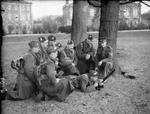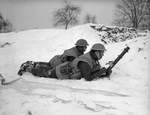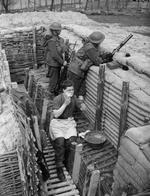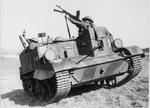Ordnance SBML 2-inch Mortar Launcher
| Country of Origin | United Kingdom |
| Type | Launcher |
| Caliber | 50.800 mm |
| Length | 530.000 mm |
| Weight | 4.800 kg |
| Ammunition Weight | 0.96 kg |
| Rate of Fire | 8 rounds/min |
| Range | 460.000 m |
Contributor: C. Peter Chen
ww2dbaseThe Ordnance SBML 2-inch light mortars were developed in the mid-1930s, with the design's foundation based on a license of a 50-millimeter mortar design by the firm Esperanza y Cia of Spain. Ten examples were built for trials in Nov 1937, along with 1,600 rounds of high explosive shells and 1,600 rounds of smoke shells. In Feb 1938, the trials were deemed successful, and an order for mass production was given. Typically, they were each operated by a crew of two, with one man holding and aiming the barrel, while the other dropping the shells into the barrel. By 1939 when the European War of WW2 began, about 500 of them were in service with the British Army. These weapons of the initial variant were designated as Mk II despite being the first variant of the design; the designation Mk I was used by a unrelated WW1-era launcher of similar caiber. These weapons' greatest advantages were their operational simplicity (painted white lines to indicate firing direction, rather than the use of sights) and their light weight (no bipods; curved base plates). Several different variants were produced, including short-barreled variants for airborne use and variants designed specifically for mounting on vehicles. They typically fired 1.02-kilogram high explosive shells, but they could also employ a wide range of alternate ammunition, including smoke shells, illuminating shells, and the atypical shells that could cast net filled with explosives meant to detonate mines in suspected enemy minefields. They were used widely by British and Commonwealth units during WW2, and many saw action in the subsequent Korean War. After the Korean War, they remained in British service as launchers for smoke and illuminating shells until the 1980s. Indian Army's 51-millimeter E1 mortars, still in production and still in operation at the time of this writing, were developed from the Ordnance SBML 2-inch mortar design.
Source: Wikipedia
ww2dbaseLast Major Revision: May 2018
Ordnance SBML 2-inch Mortar Launcher Mapa Interativo
Photographs
 |  |  |  |
Você gostou deste artigo ou achou este artigo útil? Se sim, considere nos apoiar no Patreon. Qualquer valor já vai ajudar! Obrigado. Por favor, ajude-nos a divulgar o site: Fique atualizado com WW2DB: |

- » Wreck of Teruzuki Found (27 jul 2025)
- » USS Orlean's Bow Found (22 jul 2025)
- » The Emperor of Japan Planned to Honor WW2-era Japanese POWs in Mongolia (4 jul 2025)
- » US State Lawmaker John Winter Caught Using Racial Slur "Jap" and Apologized (11 jun 2025)
- » US Government Plans to Purge WW2 Information (17 mar 2025)
- » Ver todas as notícias
 |
- » 1,181 biografias
- » 337 eventos
- » 45,111 entradas na linha do tempo
- » 1,246 navios
- » 350 modelos de aeronaves
- » 207 modelos de veículos
- » 376 modelos de armas
- » 123 documentos históricos
- » 261 instalações
- » 470 eventos
- » 28,473 fotos
- » 365 mapas
George Patton, 31 May 1944
Por favor, considere nos apoiar no Patreon. Mesmo R$1 por mês já faz uma grande diferença. Obrigado!
Ou, por favor, nos apoie adquirindo alguns produtos do WW2DB na TeeSpring. Obrigado!